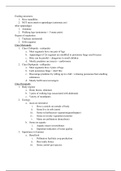Hexapod Study guides, Class notes & Summaries
Looking for the best study guides, study notes and summaries about Hexapod? On this page you'll find 6 study documents about Hexapod.
All 6 results
Sort by
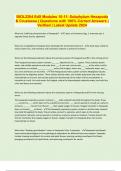
-
BIOL2204 EdX Modules 10-11: Subphylum Hexapoda & Crustacea | Questions with 100% Correct Answers | Verified | Latest Update 2024
- Exam (elaborations) • 6 pages • 2023
-
- $8.49
- + learn more
What are 3 defining characteristics of Hexapoda? - 3 pairs of uniramous legs, 1 antennae pair, 3 tagmata (head, thorax, abdomen) What are 2 adaptations Hexapoda have developed for terrestrial existence? - A hard waxy cuticle to reduce water loss, and excretory and respiratory systems to preserve moisture. Write out the following statement about the excretory system of Hexapoda and fill in the missing terms: The Hexapoda excretory system contains ___ ___ attached to the ___ system. These tub...
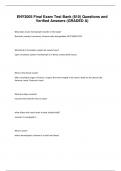
-
ENY3005 Final Exam Test Bank (810) Questions and Verified Answers (GRADED A)
- Exam (elaborations) • 129 pages • 2024
-
- $11.49
- + learn more
What does insect hemolymph transfer in the body? Nutrients, wastes, hormones, immune cells and peptides, BUT NEVER O2!! What kind of circulatory system do insects have? open circulatory system: hemolymph is in direct contact with tissues Brainpower Read More What is the dorsal vessel? Main circulatory organ of insects. It spans the entire length of an insect's body on the dorsal side. Anterior: aorta. Posterior: heart What are Alary muscles? muscles that hold the heart in...
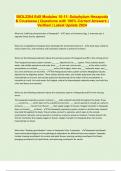
-
BIOL2204 EdX Modules 10-11: Subphylum Hexapoda & Crustacea | Questions with 100% Correct Answers | Verified | Latest Update 2024
- Exam (elaborations) • 6 pages • 2024
- Available in package deal
-
- $8.49
- + learn more
What are 3 defining characteristics of Hexapoda? - 3 pairs of uniramous legs, 1 antennae pair, 3 tagmata (head, thorax, abdomen) What are 2 adaptations Hexapoda have developed for terrestrial existence? - A hard waxy cuticle to reduce water loss, and excretory and respiratory systems to preserve moisture. Write out the following statement about the excretory system of Hexapoda and fill in the missing terms: The Hexapoda excretory system contains ___ ___ attached to the ___ system. These tub...
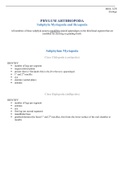
-
Subphyla Myriapoda and Hexapoda lab notes
- Class notes • 5 pages • 2021
- Available in package deal
-
- $5.49
- + learn more
Discusses structures and identifying characteristics of both subphyla. In depth Grasshopper dissection discussion, and all identifying taxonomic classification described.
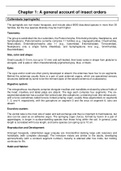
-
Class notes Biology (Zoo-) Imms’ General Textbook of Entomology, ISBN: 9789401704724
- Class notes • 38 pages • 2021
-
- $7.49
- + learn more
Insects or Insecta are pancrustacean hexapod invertebrates and the largest group within the arthropod phylum. Insects have a chitinous exoskeleton, a three-part body, three pairs of jointed legs, compound eyes and one pair of antennae. Easy notes to classify insects up to orders...
It talks about the class of myriopods and hexapods which have subclasses. It talks about their body regions, ecology, and differentiates between them.

Study stress? For sellers on Stuvia, these are actually golden times. KA-CHING! Earn from your study resources too and start uploading now. Discover all about earning on Stuvia



